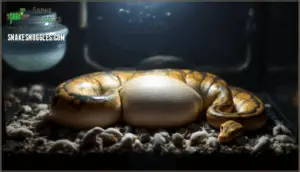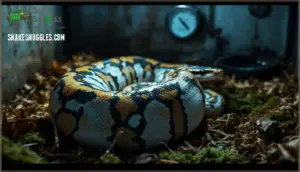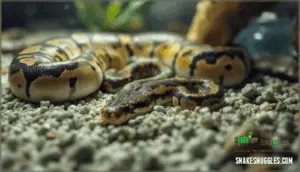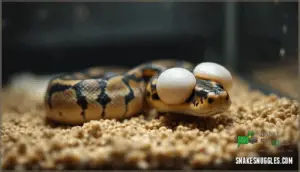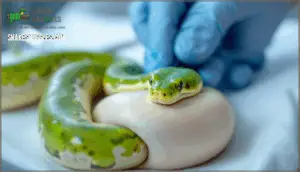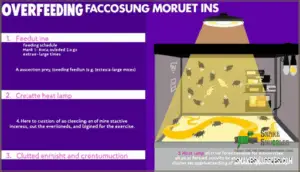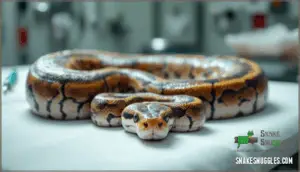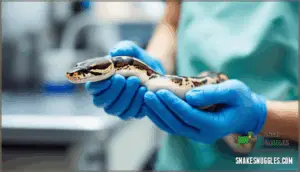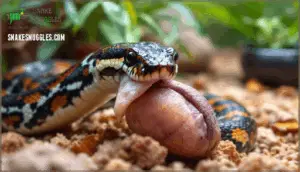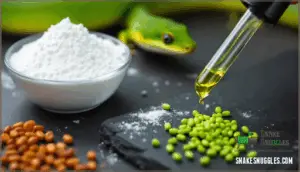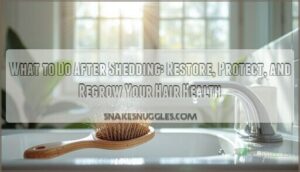This site is supported by our readers. We may earn a commission, at no cost to you, if you purchase through links.

The tricky part? Snakes are opportunistic eaters—they’ll consume prey whenever it’s available, regardless of whether they actually need it. This means you’re the gatekeeper of your snake’s health, and knowing the signs of overfeeding is essential.
From bloated bellies and thickened necks to regurgitation and breathing difficulties, your snake sends clear signals when it’s eating too much. Understanding these warning signs lets you adjust feeding schedules before minor mistakes become major health crises.
Table Of Contents
- Key Takeaways
- Recognizing Overfeeding in Snakes
- Signs of Overfeeding a Snake
- Factors Contributing to Overfeeding
- How to Prevent Overfeeding Your Snake
- Common Health Issues Caused by Overfeeding
- Managing Your Snake’s Weight
- Snake Feeding Mistakes to Avoid
- Supplements and Vitamins for Snakes
- Providing Fresh Water for Your Snake
- Adjusting Your Snake’s Feeding Schedule
- Frequently Asked Questions (FAQs)
- How do you know if a snake is overfed?
- Can You overfeed a snake?
- What happens if a snake eats too much?
- How do you feed a snake?
- Can you give a snake live prey?
- How do you take care of a snake?
- How do you know if a snake is overfeeding?
- How do I know if my snake is eating too much?
- Why is my snake sluggish after a big meal?
- Are snakes overweight?
- Conclusion
Key Takeaways
- Snakes are opportunistic eaters that will consume food whenever available regardless of actual need, making you responsible for preventing overfeeding through careful portion control and feeding schedules matched to their age, size, and metabolism.
- Physical warning signs of overfeeding include rapid weight gain, abdominal swelling, stretched ventral scales, thickened neck, and behavioral changes like lethargy, reduced activity, and loss of interest in exploring their environment.
- Overfeeding causes serious health complications beyond visible weight gain, including fatty liver disease, organ damage, metabolic disorders affecting calcium and phosphorus balance, respiratory problems from lung compression, digestive issues like regurgitation and constipation, and difficulty shedding.
- Preventing overfeeding requires adjusting feeding frequency as snakes mature (juveniles weekly, adults every 7-14 days), selecting prey no wider than the snake’s thickest body point, providing climbing structures and enrichment for exercise, and maintaining consistent feeding schedules rather than irregular patterns that trigger compensatory overeating.
Recognizing Overfeeding in Snakes
Knowing when you’ve crossed the line from proper feeding to overfeeding can save your snake from serious health problems down the road. Your snake’s body will show you clear warning signs if you’re offering too much food, but you need to know what to look for.
Let’s break down the physical changes, behavioral shifts, and health risks that signal you’re feeding too generously.
Physical Signs of Overfeeding
Overfeeding doesn’t always announce itself with flashing neon signs, but your snake’s body will tell the story if you know what to look for. Think of it like spotting weight gain in yourself—subtle at first, then unmistakable.
Watch for these telltale signs:
- Rapid weight gain beyond normal growth patterns
- Abdominal swelling creating a bulky belly
- Swollen ventral scales that look stretched tight
- Thickened neck that disrupts the snake’s natural taper
- Increased body length with obvious obesity in snakes
These physical changes mean your snake’s carrying too much weight.
Behavioral Changes Due to Overfeeding
While physical changes paint one side of the picture, your snake’s behavior might be waving an even bigger red flag. Overfed snakes often show lethargy and sluggish behavior, lounging around instead of exploring their environment. You’ll notice reduced activity levels and energy loss—they’re basically couch potatoes with scales.
| Behavioral Changes Due to Overfeeding | What You’ll See |
|---|---|
| Lethargy & Reduced Hunting | Your snake stays curled up, ignoring prey or showing little interest in feeding time |
| Social Withdrawal & Basking Changes | Less time basking, more hiding, avoiding interaction completely |
| Erratic Behavior | Unusual aggression or unpredictable movements that break normal patterns |
These behavioral red flags deserve your attention just as much as physical symptoms.
Health Risks Associated With Overfeeding
Those behavioral shifts you’re seeing? They’re often just the beginning. Obesity risks in snakes go much deeper than a lazy afternoon—they’re linked to organ damage, particularly fatty liver disease, which stresses the liver and cardiovascular system.
Overfeeding can trigger metabolic disorders that throw off calcium and phosphorus balance, sometimes leading to bone issues. Digestive issues like regurgitation and constipation become common, and over 30% of deaths in captive snakes connect back to dietary mismanagement.
Overfeeding triggers metabolic disorders, digestive issues like regurgitation and constipation, and contributes to over 30% of captive snake deaths
A significant factor is lack of space for exercise, which contributes to weight gain. The bottom line? Health risks associated with overfeeding can seriously cut your snake’s lifespan short.
Signs of Overfeeding a Snake
Spotting overfeeding in your snake isn’t always obvious at first glance. Your snake’s body and behavior will tell you when things are off balance, though it takes a trained eye to catch the early warning signs.
Let’s walk through the key indicators that suggest you’re offering too much food too often.
Rapid Weight Gain
If your snake’s waistline is expanding faster than your own after the holidays, you’ve got a problem on your hands. Rapid weight gain is one of the clearest signs of overfeeding and can lead to serious snake obesity. Here’s what to watch for:
- Visible belly swelling that makes your snake look like it swallowed a tennis ball.
- Sluggish behavior when your normally active snake barely moves.
- Weight gain speed that doubles ideal weight within months, indicating health risks ahead.
Digestive Issues
When your snake’s digestive system starts waving a red flag, you’ll notice regurgitation risks and bloating signs that are hard to miss. Overfeeding overloads the gastrointestinal tract, causing impaction issues like mid-body swelling and constipation. If prey size exceeds 15-20% of your snake’s body weight, regurgitation becomes likely.
You might also see malabsorption effects—weight loss despite frequent feeding—or delayed digestion that leads to snake lethargy and persistent bloating. Snake obesity compounds these digestive issues, pressing on internal organs and making breathing difficult. Addressing snake constipation issues may require veterinary intervention.
Reduced Activity Levels
When your snake starts moving like it’s wading through peanut butter instead of gliding with its usual grace, that’s your cue something’s off. Overfed snakes develop obesity that causes sluggish behavior and difficulty moving. This lethargy impacts their overall snake health because excess weight leads to muscle atrophy and puts strain on their organs.
Here’s what reduced hunting activity looks like:
- Your snake barely explores its enclosure anymore
- It ignores prey or shows zero interest in feeding
- Movement becomes labored, like every inch is exhausting
Exercise importance can’t be overstated—digestion impact from overfeeding creates a vicious cycle where snake lethargy prevents natural activity.
Difficulty Shedding
Healthy skin turnover depends on balanced nutrition, but an overweight snake wearing too much baggage under its scales won’t slip out of its old skin the way nature intended. Obesity in snakes disrupts normal shedding frequency, and you’ll spot retained eyecaps clinging like stubborn stickers.
Low humidity levels make difficulty shedding worse, creating perfect conditions for skin infections.
These signs of overfeeding snakes point to serious health risks associated with overfeeding. Use a shedding aid like a humidity box, but remember that fixing snake health starts with proper feeding, not Band-Aid solutions.
Regurgitation and Bloating
Your snake’s stomach isn’t a bottomless pit, and when you push it past its limit, you’ll see the consequences come right back up—literally. Regurgitation and bloating are red flags waving from your snake’s belly, signaling digestive issues you can’t ignore.
Watch for these signs of overfeeding snakes:
- Regurgitation causes: Oversized meals overwhelm the digestion timeline
- Bloating severity: Visible abdominal swelling lasting days
- Feeding management: Skip meals after regurgitation for two weeks
- Veterinary intervention: Seek help if health risks associated with overfeeding persist
Factors Contributing to Overfeeding
Overfeeding doesn’t happen by accident—it’s usually the result of specific choices and conditions in your snake’s care routine. Several factors can push you toward giving your snake too much food, even when you think you’re doing everything right.
Let’s look at what might be causing the problem so you can adjust your approach.
Feeding Frequency and Overfeeding
Think of feeding frequency like a ticking clock—get the timing wrong, and your snake’s health pays the price. Overfeeding a snake often happens when feeding intervals don’t match the snake’s age and metabolism.
Juvenile snakes need meals every 5–7 days because they’re growing fast, but adults only require food every 7–14 days or even longer, depending on species variation. Ball pythons, for example, shift from weekly feedings to every 15–20 days as adults.
If you keep feeding an adult snake like it’s still a juvenile, you’re setting up for obesity in snakes, regurgitation, and organ strain. Snake overfeeding signs like rapid weight gain appear quickly when feeding frequency stays too high.
Always adjust feeding intervals as your snake matures, and seek veterinary guidance to tailor adult schedules for your specific species.
Prey Size and Overfeeding
Feeding prey that’s too large for your snake’s body is like trying to swallow a basketball—it just doesn’t end well. Overfeeding a snake with oversized prey items causes regurgitation, digestive stress, and serious health complications.
Your prey item size should match your snake’s body width at its thickest point—accuracy matters for digestion efficiency and preventing obesity in snakes.
Avoid these snake feeding mistakes to avoid nutritional imbalance and overfeeding consequences that shorten your pet’s life.
Snake Age and Size
Just like a teenager eats more than a senior citizen, your snake’s appetite and nutritional needs shift dramatically throughout its life. Hatchlings and juveniles need frequent meals—sometimes weekly—to fuel their rapid growth rate, while adult snakes thrive on less frequent feedings, often every 10-14 days.
Adjusting feeding schedules based on snake age and size prevents obesity and keeps your pet healthy. Monitor your snake’s body condition regularly, and remember that brumation effects can temporarily reduce appetite in cooler months.
Environmental Factors
Temperature and lighting aren’t just comfort settings—they’re appetite triggers that can push your snake to overeat without you realizing it. When temperature gradients run too warm, your snake’s metabolism kicks into overdrive, making it seem ravenous. Poor lighting cycles mess with natural feeding rhythms, while inadequate enclosure size limits movement and exercise. Humidity levels that swing wildly can stress your snake into comfort eating.
Climate control isn’t optional—it’s essential for preventing overfeeding. Add habitat enrichment like branches and hides to keep your snake active and mentally engaged, naturally balancing appetite with activity.
How to Prevent Overfeeding Your Snake
Preventing overfeeding doesn’t require guesswork—it’s about building smart habits that keep your snake healthy for years to come. You’ll need to focus on a few key areas, from timing meals correctly to picking the right prey size.
Let’s walk through the main strategies that’ll help you avoid the overfeeding trap.
Proper Feeding Schedules
Setting up the right feeding routine takes a bit of planning, but it’s easier than teaching your snake to fetch. Track feeding frequency based on your snake’s age and activity levels—young ones usually eat weekly, while adults can go 10–14 days between meals. Here’s what to monitor:
- Age considerations: Young snakes need frequent meals for growth
- Seasonal adjustments: Metabolism slows in cooler months
- Activity levels: More active snakes require consistent feeding schedules
- Health monitoring: Adjusting feeding schedules based on snake age and size prevents overfeeding
Prey Selection and Portion Control
Once you’ve nailed down when to feed your snake, the next step is figuring out what to offer and how much will keep them healthy without tipping the scales. Snake feeding guidelines suggest choosing appropriate prey size—generally no wider than the thickest part of your snake’s body. Start with smaller portions for young snakes and use size progression as they grow.
Frozen vs. live prey both work, though frozen is safer and easier to control nutritionally. Vary prey types when possible to guarantee balanced nutritional content.
Stick to consistent portion frequency matching your snake’s age, and you’ll avoid the bloating and digestive drama that comes with overfeeding.
Encouraging Exercise and Activity
You can’t exactly strap a Fitbit on a snake, but keeping them moving matters more than most owners realize. Enclosure enrichment—like climbing opportunities and varied terrain—turns your snake enclosure into a mini obstacle course.
Regular interaction sessions and supervised exploration outside the habitat boost activity levels, helping with weight management and preventing obesity. Think of it as cross-training for reptiles, minus the sweatbands.
Regular Veterinary Check-Ups
Most snake owners don’t think twice about skipping the vet until something goes wrong, but catching problems before they snowball can mean the difference between a quick fix and a serious health crisis.
Regular veterinary checkups give you expert advice on health monitoring, including early detection of obesity in snakes and digestive troubles.
Preventative care like parasite screening keeps health risks manageable, so your snake thrives instead of just surviving.
Common Health Issues Caused by Overfeeding
Overfeeding doesn’t just make your snake chubby—it can trigger serious health problems that affect everything from breathing to digestion. These issues range from uncomfortable to life-threatening if left unchecked.
Let’s look at the most common health complications you’ll want to watch for in an overfed snake.
Obesity and Organ Dysfunction
When obesity sets in, it’s like your snake’s organs are hosting a party they never signed up for. Fat deposits accumulate around important organs, causing serious dysfunction that can shorten your snake’s life dramatically. Here’s what happens inside an overfed snake:
- Fatty liver disease develops when excessive fat infiltrates the liver, compromising its ability to detoxify blood and process nutrients
- Kidney disease and heart disease become real threats as visceral fat accumulates and strains these organs
- Spinal pressure from fat infiltration around the spinal cord reduces flexibility and can cause neurological problems
- Metabolic effects disrupt calcium and phosphorus balance, leading to additional disorders beyond liver damage
- Gastrointestinal and respiratory tracts get compressed by fat, causing impaired function and possible stasis
Obesity in snakes isn’t just about appearance—it’s a cascade of health risks that affects every major system.
Respiratory Problems
When your snake’s breathing sounds more like wheezing through a straw than smooth silence, something’s gone wrong. Overfeeding creates respiratory problems by compressing the lungs with excess fat, leading to breathing difficulty and labored respiration. Watch for pneumonia symptoms like open-mouth breathing or mucus discharge.
Regurgitation and bloating from overfeeding a snake increase aspiration risks, where stomach contents enter the airways.
Proper humidity control and immediate veterinary care with medication options can address these health risks of overfeeding before they threaten your snake’s wellbeing.
Digestive Issues and Regurgitation
Digestive problems from overfeeding can overwhelm your snake’s system, triggering regurgitation when prey exceeds 15-20% of body weight. Bloating signs include visible abdominal distension and gas buildup, while impaction risks increase with oversized or too-frequent meals.
Malabsorption effects may follow, causing nutritional deficiencies despite regular feeding. Putrefaction dangers arise when undigested food decomposes internally, potentially leading to life-threatening infections requiring immediate veterinary intervention.
Skin Problems and Infections
Excess weight isn’t just about a bulging belly—it creates the perfect storm for skin infections that can turn your snake’s scales into a breeding ground for trouble. Obesity in snakes compromises immune function, making your pet vulnerable to mite infestations, fungal infections, and bacterial dermatitis. Moisture trapped in skin folds becomes a haven for scale rot, while difficulty shedding creates openings for infection.
Common skin problems from overfeeding include:
- Mite infestations that thrive on stressed, overweight snakes
- Scale rot developing in damp skin folds and poorly shed areas
- Fungal infections targeting weakened immune systems and retained shed
Managing Your Snake’s Weight
Keeping your snake at a healthy weight isn’t guesswork—it requires consistent monitoring and smart adjustments. You’ll need to track changes regularly, tweak feeding routines when needed, and make sure your snake stays active and well-nourished.
Here’s how to manage your snake’s weight effectively.
Monitoring Weight Gain
Tracking your snake’s body condition over time reveals patterns that casual observation might miss. Monthly weigh-ins help you establish weight benchmarks and catch rapid weight gain early—before obesity in snakes becomes a real problem.
Use a digital scale for accuracy, and keep records to track growth patterns. If your snake’s gaining weight faster than expected or you’re unsure about their body condition, a veterinary assessment can provide clarity and peace of mind.
Adjusting Feeding Schedules
Once you’ve understood your snake’s weight trends, the next step is fine-tuning when and how often you offer meals. Adjusting your snake’s feeding schedule based on individual needs keeps them healthy.
Snake feeding guidelines aren’t one-size-fits-all. Monitoring snake health and adjusting feeding accordingly prevents obesity while supporting proper growth.
- Age considerations – juveniles eat weekly, adults every 10-14 days
- Seasonal changes – appetite drops in winter months
- Breeding cycles – females need less during gestation
- Shedding periods – skip meals when eyes cloud over
- Tracking feeding frequency and amount – monitor response to each meal
Encouraging Physical Activity
If your feeding schedule is dialed in but your snake still looks like it’s been skipping gym day, it’s time to rethink how much they’re actually moving around their enclosure. Encouraging exercise and activity isn’t complicated—it’s about enrichment ideas that tap into natural foraging behavior.
Add climbing structures, rotate hiding spots, and allow supervised exploration outside the tank. Snake body condition monitoring improves when you boost their activity level, reducing obesity risks and supporting overall snake health.
| Enrichment Type | Purpose |
|---|---|
| Climbing Structures | Builds muscle tone and burns calories |
| Foraging Behavior | Stimulates natural hunting instincts |
| Exercise Equipment | Increases daily movement patterns |
| Supervised Exploration | Encourages curiosity and physical engagement |
Providing a Balanced Diet
You can toss all the mice you want at your snake, but if those meals don’t match their actual nutritional needs, you’re basically filling their tank with empty calories. Think of it like this: your snake needs prey variety to cover nutrient requirements, not just volume.
Rotate prey size based on snake feeding guidelines, practice portion control, and use supplementation methods like calcium dusting when needed. Don’t forget balanced hydration—fresh water matters as much as feeding frequency.
A proper snake diet means matching snake nutrition to their body condition, not their appetite.
Snake Feeding Mistakes to Avoid
Even experienced snake keepers can fall into feeding traps that hurt their pet’s health. The good news is that most mistakes are easy to fix once you know what to watch for.
Let’s look at the most common feeding errors and how to steer clear of them.
Overfeeding and Underfeeding
Finding the right balance between too much and too little food isn’t just important—it’s the difference between a thriving snake and one struggling with preventable health problems. Overfeeding causes obesity, regurgitation, and digestive issues that shorten your snake’s life. Underfeeding stunts growth rate and weakens immunity.
These feeding imbalances create serious health implications that proper weight management and owner education can prevent—track feedings, adjust portions as your snake grows, and watch for health issues before they escalate.
Poor Prey Quality and Presentation
A snake won’t complain about stale food, but its digestive system definitely will—and by then, you’re already looking at trouble. Poor prey quality and presentation methods directly affect prey nutritional value and your snake’s health. Here’s what proper snake feeding practices require:
- Prey storage at correct temperatures prevents bacterial contamination
- Thawing practices must be gradual—never use microwaves
- Gut loading rodents before freezing boosts nutritional content
- Appropriate prey size matches your snake’s girth
- Prey selection and portion control prevents digestive stress
Fresh, properly thawed meals keep your snake thriving.
Inadequate Feeding Frequency
Skipping meals might seem like a way to keep your snake lean, but irregular feeding schedules can actually backfire and trigger overeating when food finally arrives. When your snake goes too long between meals, its metabolism adjusts downward—think of it like entering hibernation mode. Once you feed after a gap, your snake compensates by consuming more than usual, disrupting digestive efficiency and potentially causing regurgitation or obesity over time.
| Feeding Pattern | Result |
|---|---|
| Consistent meals | Stable metabolism, healthy growth |
| Missed feedings | Compensatory overeating, digestive stress |
| Infrequent meals | Nutritional deficiencies, stunted growth |
| Irregular timing | Erratic appetite, overfeeding risk |
| Proper schedule | Best nutrition, disease prevention |
Consistency matters more than quantity. Your snake thrives on predictable feeding routines that support steady growth without the boom-bust cycle of undernourishment followed by overfeeding. This prevents signs of overfeeding like regurgitation while avoiding underfeeding signs such as growth stunting and nutritional deficiencies.
Lack of Fresh Water
Water might seem like the forgotten sidekick in snake care, but dehydration can quietly sabotage your feeding routine and throw your snake’s whole system out of balance. A dehydrated snake struggles to digest food properly, which can lead to regurgitation and metabolic slowdowns. Without adequate hydration, your snake’s shedding becomes difficult, and its body can’t process nutrients efficiently—even from perfectly-sized meals.
Keep your snake’s water requirements in check:
- Provide a water dish large enough for soaking
- Change water daily to maintain quality
- Monitor drinking frequency as a health indicator
- Maintain humidity levels appropriate for your species
- Watch for dehydration signs like wrinkled skin or retained shed
Fresh water isn’t optional—it’s as essential to preventing feeding problems as the right prey size itself.
Supplements and Vitamins for Snakes
Your snake’s diet needs more than just food—it needs the right nutritional support to stay healthy and thrive. Calcium and vitamin D3 are particularly important since they prevent serious conditions like metabolic bone disease, which can cripple your snake over time.
Let’s look at the different supplement options and how to use them correctly.
Importance of Calcium and Vitamin D3
Calcium and vitamin D3 work together like a powerful duo for your snake’s skeletal health. Calcium strengthens bones and aids muscle function, while vitamin D3 helps your snake absorb that calcium efficiently.
When whole prey is fed, snakes usually get sufficient calcium from bones, but without proper UV-B exposure or supplementation, vitamin D3 deficiency can trigger metabolic bone disease—characterized by weak bones, difficulty shedding, and deformities.
The calcium-to-phosphorus ratio should stay around 1.5:1 to 2:1 for ideal mineralization. If your snake lacks UV-B lighting, consider supplements containing less than 23,000 IU/kg of vitamin D3, administered once or twice monthly to prevent both deficiency and toxicity.
Types of Supplements for Snakes
Think of supplements as your snake’s nutritional insurance policy—they fill in the gaps that even whole prey can’t always cover. Multivitamins and mineral additives provide essential nutrients, while calcium supplements and vitamin D3 work together to prevent metabolic bone disease.
Liquid supplements and powdered supplements each have their strengths—liquids mix easily with food, while powders coat prey directly. Omega-3 sources boost skin and immune health. Probiotics can ease digestive issues, especially helpful when addressing overfeeding symptoms.
These supplements complement a balanced diet rather than replace it.
Administering Supplements Safely and Effectively
Getting the dosage right with supplements is where many well-meaning snake owners stumble—too little and you’re not helping, too much and you could actually hurt your pet. Always follow your vet’s specific dosage calculation for your snake’s size and species.
Timing matters too: administer supplements with meals to improve absorption. Never mix multiple supplements without veterinary guidance, as calcium-phosphorus imbalance or vitamin toxicity can develop. Use powders on prey or liquids mixed into food.
Your vet remains your best resource for preventing deficiency and metabolic bone disease.
Providing Fresh Water for Your Snake
Water is just as critical to your snake’s health as food, yet it’s often overlooked by well-meaning owners. Snakes need access to fresh, clean water every single day, and how you provide it matters more than you’d think.
Let’s walk through the best ways to keep your snake hydrated and comfortable.
Water Quality and Freshness
Clean water matters more than you might think—your snake depends on it just like you do. Stagnant water breeds bacteria and parasites that’ll compromise your snake’s health fast. Change water daily and use dechlorinated tap water or a purification system for safety. Monitor hydration by checking your snake’s skin elasticity and water bowl usage:
- Daily water changes prevent bacterial growth and kidney problems
- Dechlorination or filtration removes harmful chemicals from tap water
- Humidity monitoring guarantees adequate hydration through skin absorption
Fresh water directly bolsters digestion and prevents dehydration-related complications during feeding.
Water Bowls and Hydration Systems
Your snake’s water bowl might seem simple, but the right setup makes hydration easy and keeps health problems at bay. Choose a bowl large enough for your snake to soak in comfortably—usually 1-2 inches deep works well. Ceramic or stainless steel bowls resist bacteria better than plastic, which can harbor mites over time.
Place the bowl away from heat sources but accessible to your snake. Use dechlorinated or filtered water to prevent respiratory issues and digestive problems. Clean and refill daily—stagnant water invites infections that complicate overfeeding risks.
Consider automatic watering systems for consistent hydration without daily maintenance fuss. These keep water fresher longer and reduce the stress of manual changes, especially helpful when managing feeding schedules. Either way, regular monitoring of water quality and consumption makes sure your snake stays properly hydrated.
| Setup Element | Best Practice |
|---|---|
| Water bowl size | 1-2 inches deep, large enough to soak |
| Water source type | Dechlorinated or filtered water |
| Cleaning frequency | Daily for health |
| Automatic systems | Reduces maintenance, improves consistency |
Monitoring and Maintaining Proper Humidity
Maintaining the right humidity level in your snake’s enclosure is just as important as keeping the water fresh—it’s one of those behind-the-scenes factors that directly affects whether your snake thrives or develops problems down the line.
Get a digital humidity gauge to monitor levels consistently. Most snakes need 40-60% humidity, though tropical species prefer higher ranges. Poor humidity stalls shedding success and compromises respiratory health. Provide adequate ventilation systems to prevent stagnant air while maintaining hydration balance. Adjust substrate moisture and misting schedules based on your species’ needs.
Regular enclosure setup checks during veterinary visits catch environmental factors early, preventing respiratory issues linked to overfeeding complications.
Adjusting Your Snake’s Feeding Schedule
Finding the right feeding rhythm for your snake is like tuning an instrument—too tight and things break, too loose and nothing works right. The good news is that once you understand your snake’s needs, adjusting the feeding schedule becomes straightforward.
Here’s what we’ll cover to help you dial in the perfect routine.
Tracking Feeding Frequency and Amount
Keeping detailed records of what you feed your snake—and when—is honestly one of the easiest ways to catch feeding problems before they spiral into bigger health issues. Start a simple feeding log tracking meal intervals, prey size, and the exact date and time. This helps you spot weight trends and guarantees portion consistency across feedings.
Document your snake’s appetite and growth patterns monthly. A feeding schedule chart is handy for reference. When you have this data, adjusting feeding frequency becomes straightforward—you’ll see exactly what works and what doesn’t for preventing overfeeding.
Adjusting Feeding Schedules Based on Snake Age and Size
Once you know your snake’s age and size, you’ll realize that feeding isn’t one-size-fits-all—it’s more like tailoring a meal plan to match your pet’s specific stage of life.
Hatchling feeding demands frequent meals—sometimes every 3–5 days—to fuel rapid growth. As your snake matures into the juvenile stage, juvenile portions can stretch feeding intervals to 5–7 days. Adult snakes shift to adult maintenance feeding every 7–10 days, while senior adjustments may mean spacing out meals even further.
Consider these key factors:
- Prey size should match your snake’s body width, never wider than the thickest part
- Snake weight helps you gauge whether portions are appropriate for current metabolism
- Feeding schedule flexibility accounts for breeding considerations during reproductive seasons
Monitor your snake’s body condition monthly to make certain you’re finding the right balance between nutrition and prevention.
Monitoring Snake Health and Adjusting Feeding Accordingly
If you’ve been feeding your snake on schedule but something feels off—sluggish movements, trouble shedding, or a rounder belly than usual—it’s time to take a closer look at what’s actually happening under the scales. Regular weight monitoring and body condition assessments help catch problems early. Watch for appetite changes or digestive issues like regurgitation.
Schedule vet consultations annually, or sooner if concerns arise. A reptile veterinarian can assess your snake’s specific needs and recommend feeding adjustments. Small tweaks based on weight trends and overall health make a real difference.
Frequently Asked Questions (FAQs)
How do you know if a snake is overfed?
Overfed snakes often show rapid weight gain and a noticeably thickened body shape. Look for abdominal swelling, sluggish behavior, and difficulty shedding. Digestive signs like regurgitation and bloating indicate problems. Scale appearance changes too—ventral scales may look stretched or swollen.
Reduced activity levels are common in obese snakes.
Can You overfeed a snake?
Absolutely—overfeeding snakes is surprisingly common and genuinely harmful. When you power feed or ignore your snake’s metabolism, obesity creeps in fast.
Watch for rapid weight gain, lethargy, and regurgitation. These signal serious dietary needs aren’t being met.
Stick to portion control and appropriate feeding schedules to prevent obesity in snakes and keep your snake thriving.
What happens if a snake eats too much?
Overfeeding causes serious complications. Excessive weight strains organs, leading to organ damage and a reduced lifespan. Digestive complications, such as regurgitation and fatty liver disease, can also develop.
The risk of paralysis emerges from pressure on the spinal cord. Obesity in snakes dramatically shortens their lives, underscoring the importance of quality care.
How do you feed a snake?
Many assume snakes need frequent meals, but that’s a misconception. Feed frozen-thawed prey matching your snake’s body size every 7-10 days for adults. Younger snakes eat more often.
Provide fresh water daily and add calcium-vitamin D3 supplements to prevent deficiencies and metabolic bone disease complications.
Can you give a snake live prey?
Live prey can injure your snake during feeding—a significant safety concern. Pre-killed or frozen prey eliminates injury risks while providing equal nutrition.
Consult your veterinarian about prey options that match your snake’s health needs and feeding schedule, especially when managing overfeeding concerns.
How do you take care of a snake?
Proper snake care starts with a well-designed habitat—think temperature gradients, appropriate humidity, and secure enclosures.
Feed appropriately sized prey on a schedule that matches your snake’s age and size. Monitor for overfeeding signs like obesity, regurgitation, and lethargy.
Gently interact using correct techniques. Watch for common ailments and shedding issues.
Schedule regular vet check-ups to keep your snake thriving.
How do you know if a snake is overfeeding?
Rapid weight gain is the biggest red flag. Look for sluggishness, difficulty shedding, and abdominal swelling.
Digestive signs like regurgitation and bloating mean something’s off. Activity levels drop too. Catch these early.
How do I know if my snake is eating too much?
A sluggish snake that’s packing on weight quickly is waving a red flag. Watch for a bloated belly, difficulty moving, or trouble shedding—these signal overconsumption.
Regurgitation and abdominal swelling are serious warnings. Scale back portions to keep your snake thriving.
Why is my snake sluggish after a big meal?
After a large meal, your snake enters digestion mode—like shifting into low gear. Its metabolic rate spikes as the digestive process kicks into overdrive, pulling energy from movement. This lethargy is normal, but monitor environmental temperature closely; snakes need warmth to digest efficiently.
Extreme sluggishness or regurgitation signals potential digestive issues or overfeeding problems worth investigating.
Are snakes overweight?
Yes, snakes can pack on extra pounds like a suitcase overstuffed for vacation. Watch for sluggishness, unusual fat deposits along the spine, or a bloated midsection that disrupts their sleek, healthy snake shape.
Proper prey sizing prevents obesity in snakes.
Conclusion
Studies show that nearly 60% of captive snakes are overweight, yet most owners believe they’re feeding correctly. If you’ve spotted any signs of overfeeding a snake—whether it’s rapid weight gain, regurgitation, or breathing struggles—take action now.
Adjusting meal frequency and prey size isn’t complicated, but it requires commitment. Your snake depends entirely on you to regulate its diet, and those small changes you make today could add years to its life tomorrow.
- https://www.bva.co.uk/news-and-blog/news-article/tipping-the-scales-pet-snakes-pile-on-the-pounds-due-to-diet-and-lack-of-space-say-vets/
- https://www.dvm360.com/view/approach-anorectic-reptile-proceedings
- https://www.vetlexicon.com/exotis/reptiles/gastrohepatology/articles/gastrointestinal-obstruction/
- https://lbah.com/reptile/snake-impaction/
- https://www.ingleside.com/services/other-pets/blog/common-health-problems-pet-snakes

